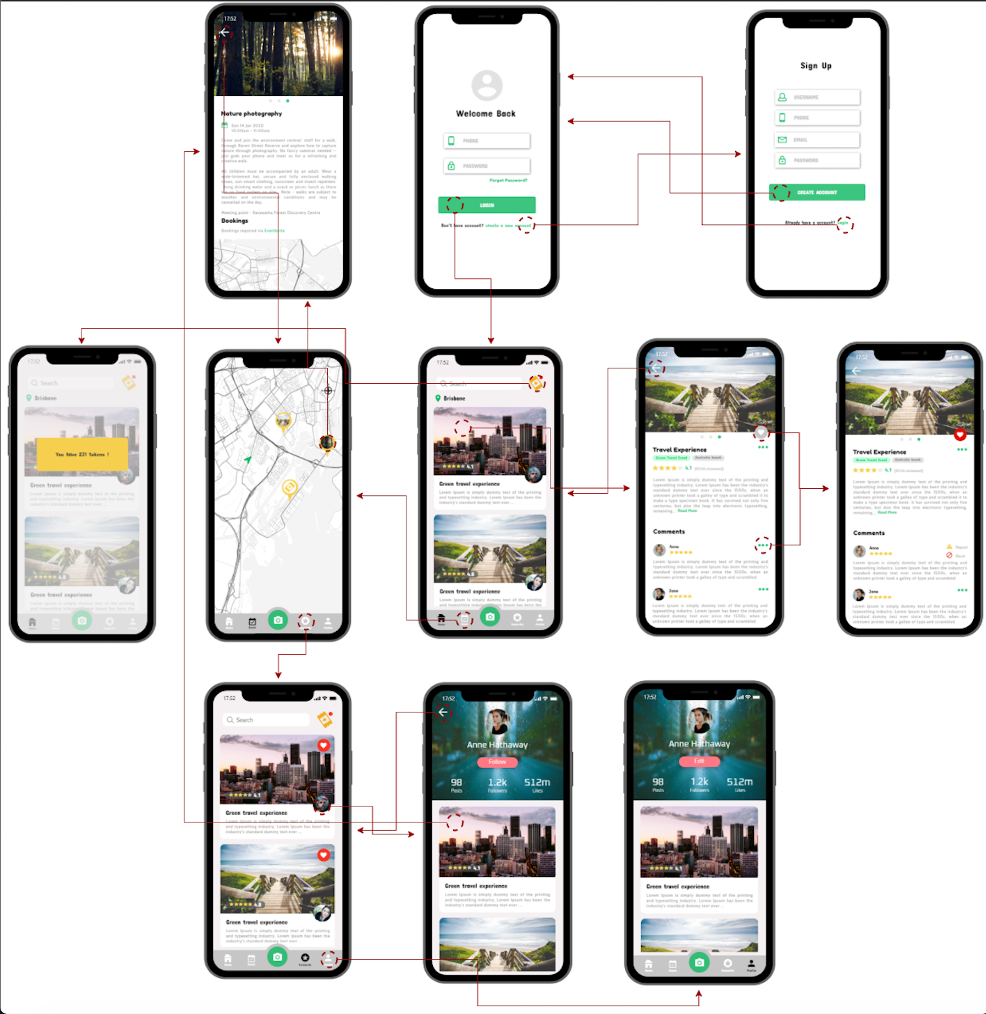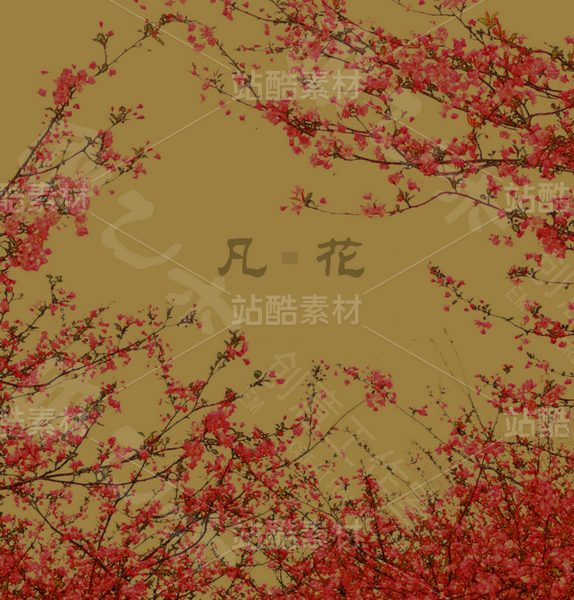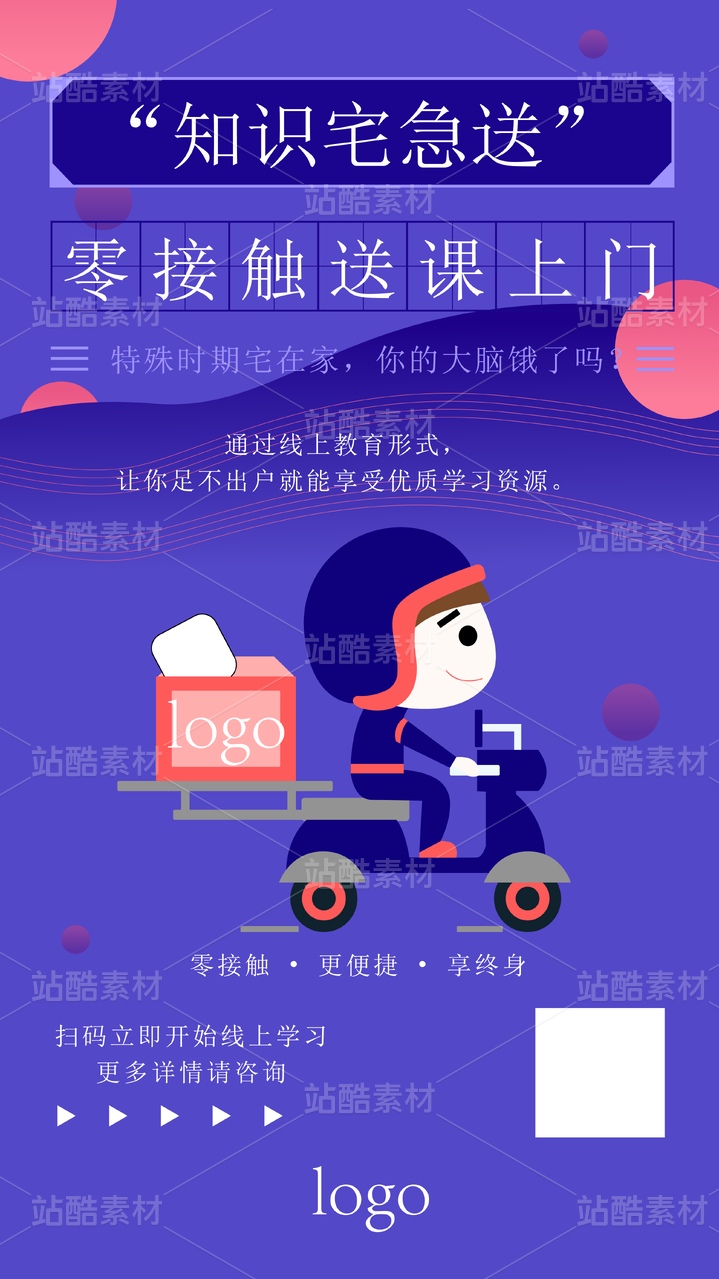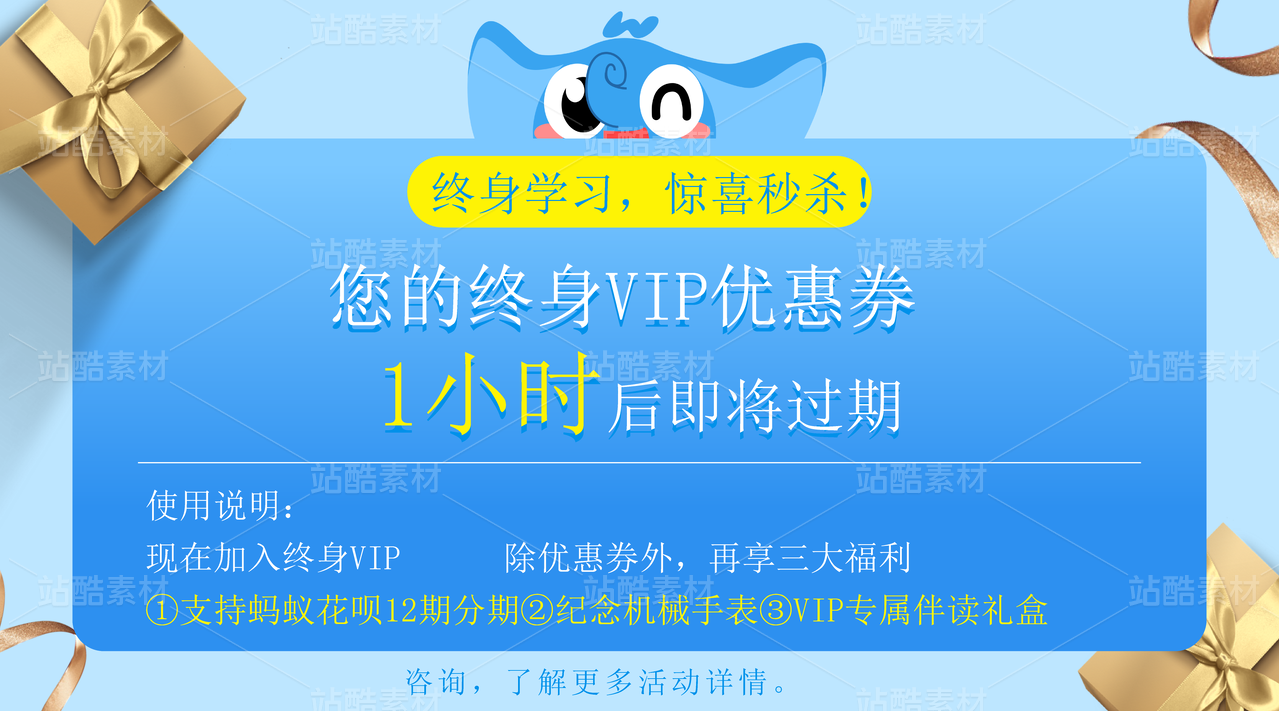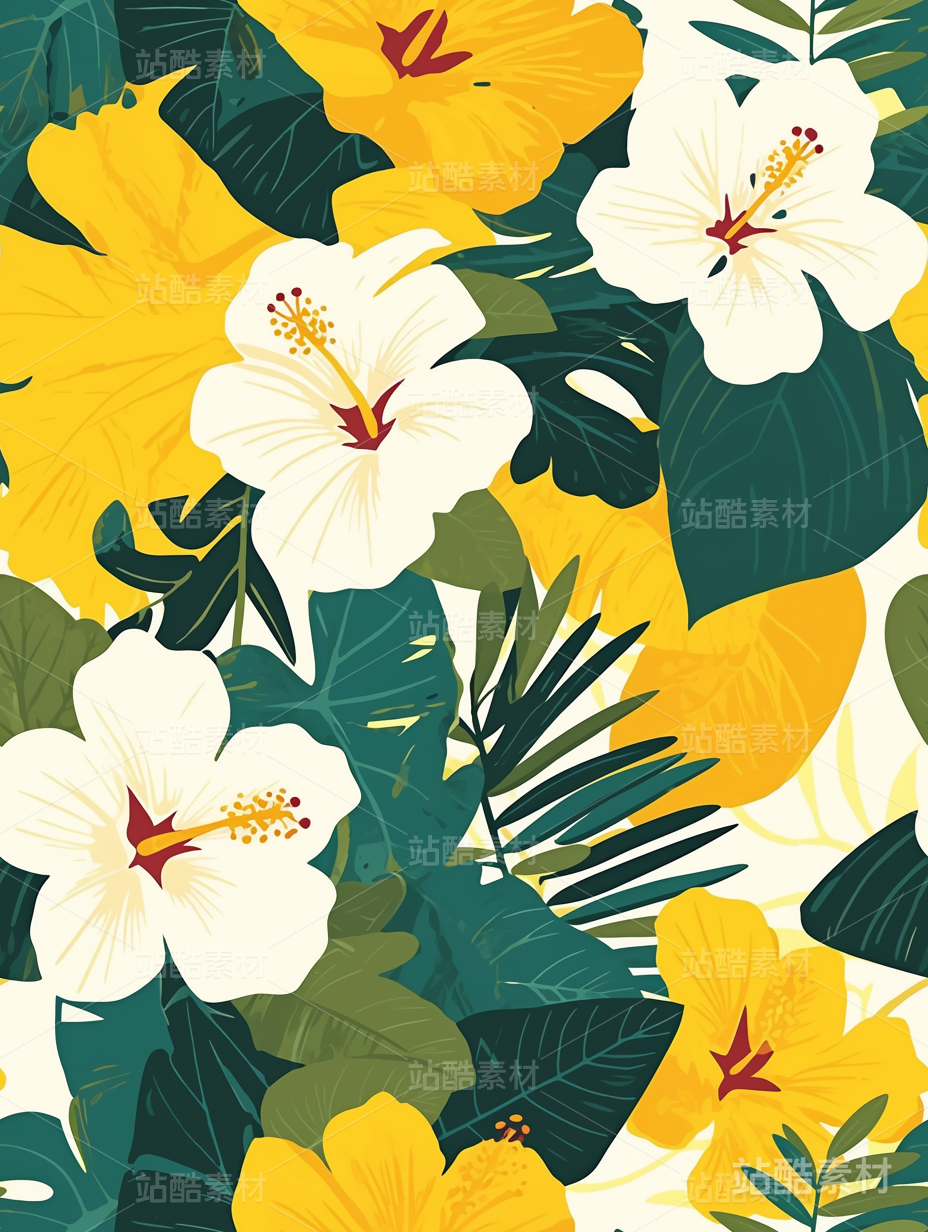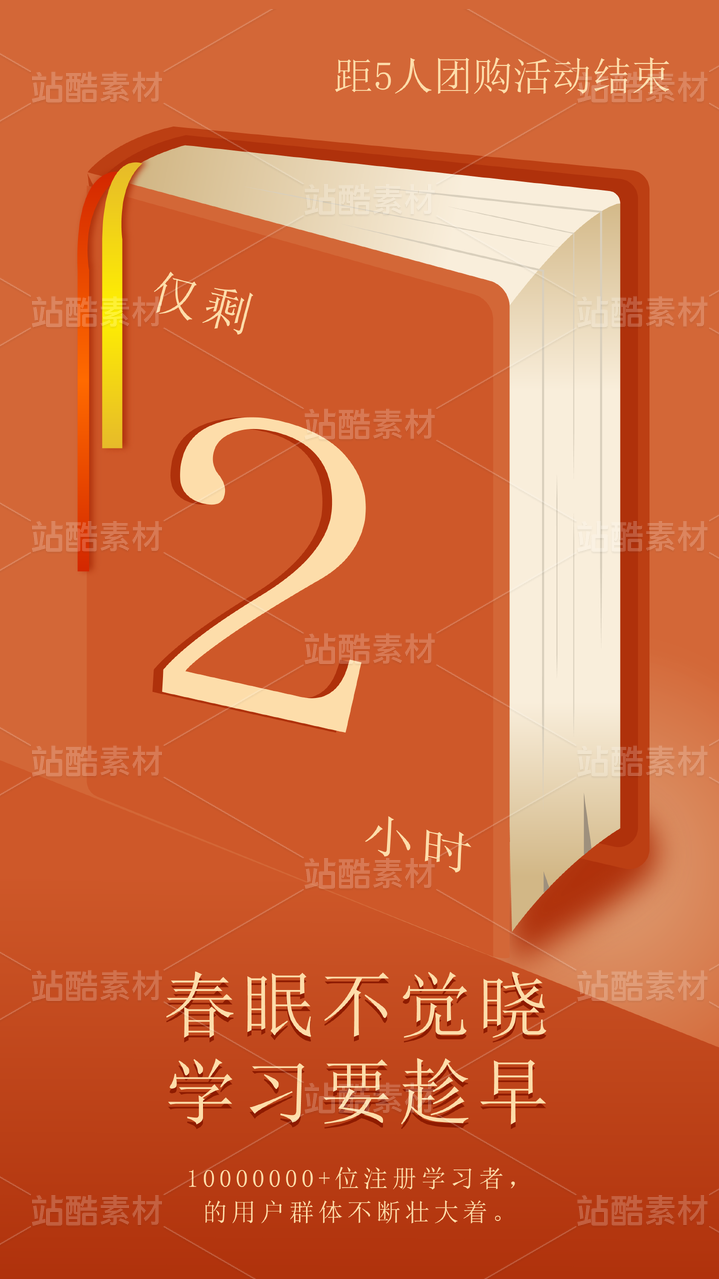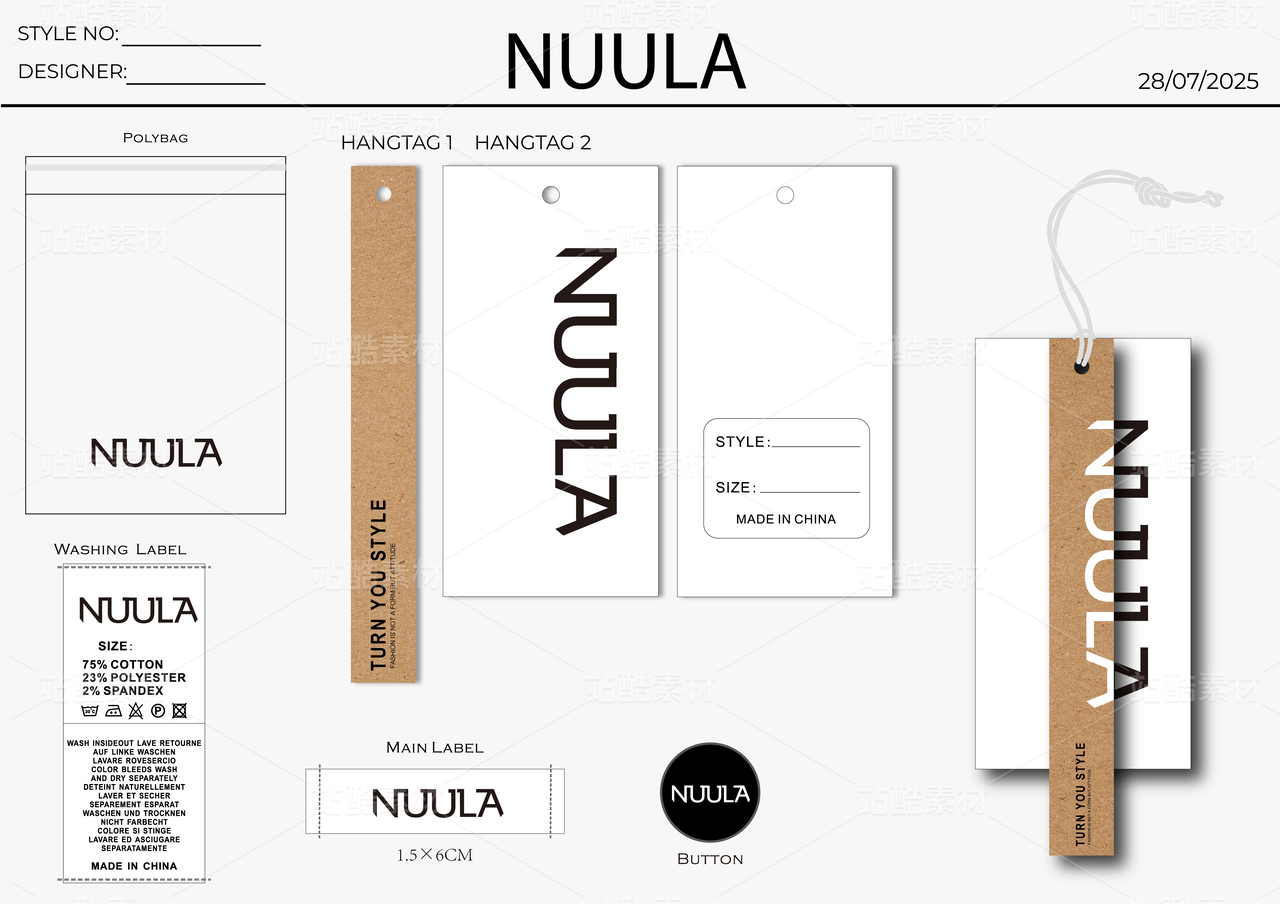序号4-旅游App-雏型概念建立-概念分化-确立方向-背景调查-用户研究-原型产生-评估反思
该项目旨在确定旅游业对当地社区造成的不利影响方面的问题空间,并提供解决问题的可能办法。

4 Conceptual model
Problem Definition
It is a mobile application that, through providing immediate short-term rewards, encourages users to complete environmentally friendly tasks and to share their green travel experiences online after participating in local culture-related activities, which aims not only to enhance the place attachment, but also to use persuasion power of social media to guide users to behave properly.
The implementation of technology
The interaction paradigm is mobile, and the solution will be built on mobile application. The reason is continuous movement is involved during travel, which means our stakeholders such as tourists might need to keep moving from one tourist sight to another. So, mobile applications are the most suitable platform to implement the solution space since they are portable and flexible so that they can be easily accessed anytime and anywhere. Moreover, they contribute to access and analyse tourists’ personal information and the information of travel destinations so that we are able to provide information that matches the user’s requirements and needs. In addition, it provides a platform to link all stakeholders such as tourists, tourism departments, and local volunteers together. So, mobile devices are necessary.
High-level description
The mobile application as a social media provides a platform which allows tourists to share their travel experience with each other. In order to achieve the goal of green tourism, this app encourages people to share environmental friendly travel experiences through an award system. For example, this app will collect nearby green travel experience events which are held by some environmental protection organization and show it on a map in the location and the tourists can decide whether to participate in any one of them. After the user finishes one activity, he/she can upload the travel experience to the community provided by the App and share it with other users. The user would get a number of e-tokens based on the difficulty of the task and the number of received positive reviews and likes. The tokens can then be exchanged for different gifts. For example, a meal coupon that relates to the user’s preferences. Moreover, the user can also check the reviews he/she got so that he/she is able to know how other people thought about it. So, the more positive reviews the user got, the more likely he/she would keep doing environmentally friendly things. This feature is created based on the first insight and the second insight of the potential solution that provides suggestions about how other people thought about posted travel experiences and providing a reward to the user if something posted online is positive and it does not involve improper behaviour, which is the Reciprocity principle mentioned in section 3.1.
Moreover, users can follow the other users they like. The user who got a number of followers will become an influencer in this App. So, if these influencers can join the daily green activities and share their environmentally friendly travel experiences, then they would guide followers to behave more properly while travelling. Also, the rewards influencers can get are more valuable than that of normal users. Therefore, the more famous influencers would post environmentally friendly travel experiences more frequently. This feature reflects the third insight of the solution of cooperating with or guiding social media influencers to share positive travel experiences online so that their followers are more likely to accept it and follow it.
On the other hand, since there are a large number of travel experiences shared in the community, the user can gradually learn the culture and characteristics of the travel destination by browsing other users’ travel experiences. Since most posts are taken from the daily green activities of the travel destination, users are also able to make travel plans based on the posts they are interested in. Moreover, based on the user’s preferences, the local activities that represent its culture and other unique features would be displayed on a map to the user, and they would also be included in the tasks to encourage the user to explore the travel destination. So, they have more opportunities to get to know something unique and different with their own culture. The overall feature aims to fulfil the fourth insight of the solution to enhance users’ place attachment.
5 Stakeholders & Personas
Stakeholders
Based on the updated research and the improved concept we formed in the previous section, the types of the stakeholders are updated. Moreover, how the concept affects them is also included in this part. The stakeholders are composed of the following types of people:
Tourists
Who wants to know what travel destination’s activities are suitable forthem.
Who like to share their travel experience online.
Who wants to support green tourism.
Who wants to know how to behave properly in the travel destination.People who use social media frequently and make travel plans as a guide.
Tourism department to raise awareness and establish relevant policies.
Local environmental-protection volunteers.
Local community.
Type 1: Tourists
Who wants to know what travel destination’s activities are suitable for them.
This type of stakeholders might be not familiar with the travel place, and they do not know what local activities it has or, they have experienced a number of activities and were not suitable for these tourists. So, they want to know what activities are suitable for them. This concept is able to match this requirement. Through exploring what the travel destination has by viewing other tourists’ posts and filter the posts based on their preferences, they are able to know what activities have and are suitable for them in the travel place, which aims to enhance their place attachment.
Who like to share their travel experience online.
This type of stakeholders is interested in sharing their travel experience on social media such as Instagram and Facebook. Compared with these social media, our concept is more focused on sharing travel experience to all tourists. It narrows down the types of audience, and other tourists are also able to see their posts. It aims to enhance the communication between the tourists in the same place, to enhance the place attachment, and to reduce the persuasive power of social media from those common platforms.
Who wants to support green tourism.
This type of stakeholders are people who care about the environment, and want to protect the local environment. However, they might not have any ideas what they can do in order to protect it. In our concept, green activities that aim to protect the environment and behave properly would be recommended to them, and they are able to support green tourism by participating in these activities. Moreover, through sharing what they have done in the community of the App, it can affect other tourists who also use this App to behave more environmentally friendly.
Who wants to know how to behave properly in the travel destination.
This type of stakeholders respect the local culture and environment, and they do not want to hurt any residents or environment because of their improper behaviour; however, due to the cultural difference, they do not know what they should do or should not do in the travel destination. In our concept, user’s posts are based on the environmentally and community friendly activities they participated in, which means posts are related to green tourism including how to behave properly in the travel place. So, through viewing other user’s posts, they are able to get to know the cultural differences and how to behave properly while travelling.
Type 2: People who use social media frequently and make travel plans as a guide
As the prevalence of technology, people are used to gaining tourist information on the social media platform, which may lead to a negative influence due to the potential destruction of the local area as the research shown in the background section.
Statistics have revealed that around 86% of people are interested in a specific location because of the user-generated content and over a half (52%) of travellers made travel plans based on the other’s posts on social media (Macdonald, L., 2019).
It implied that there are a relatively large number of people impacted by social media on making decisions on travelling to specific locations.
Furthermore, the research has proven that the mass media plays a significant role in traveller’s behavior as it impacts the tourist’s decisions (Edelheim, J. R., 2004).
Subsequently, as social media influencers post images that have negative impact on the local community, there exists potential threats to the environment. Therefore, these groups of people are our stakeholders.
The concept we formed is able to help them to make environmentally friendly travel plans through viewing other users’ travel experiences. Furthermore, the positive impact from the social media influencer in this concept is also beneficial for advocating the responsible travel habits and behaviours.
Type 3: Tourism organizations and local volunteers
The research has shown that there often exists cultural, historical and socioeconomic differences between the local residents and international tourists (Buckley, 2012). Thus, it is necessary to advocate related policies, guidance and awareness for the outcomers to protect the local culture and to emphasise the importance and consequence of their behaviours. Local volunteers play an important role in assisting the local government to develop environmentally friendly tourist attractions and to remind the local tourists about their responsibility towards the environment.
Therefore, this concept can be a platform for them to share what the cultural differences are between the local residents and international tourists as posts. Then, people who use it to make travel plans can easily understand those differences through viewing their posts. Thus, they are more likely to behave properly while traveling. Also, it can be a way to share the interesting and unique features of their local culture.
Type 4: Local community
Local community will benefit from the concept in different aspects such as tourists would behave more properly in the community and more tourists could be attracted which might improve the local economy without causing negative impacts on the environment, since it not only alleviates the harm of the environment and sociocultural by raising awareness among tourists, but also promotes the responsible travel behaviours and influencer marketing that may educate the tourists and bloom the local economy.
6 Questions/areas of investigation
In this final stage, the background research and prototype testing feedback revealed that the research of a number of aspects, such as the award system, lacked detail, and they need to be further explored in order to identify additional requirements and needs for the solutions. Based on the team discussion about these aspects, we have identified the gaps from our knowledge, and two questions that relate to these aspects need detailed research before forming the final solution.
Q1. What types of gifts are commonly accepted by tourists?
As discussed in the section 3.1 Award System Analysis, an immediate short-term award system would be used. Also, tokens are the most suitable award in our concept. Through completing tasks, a certain number of tokens are assigned to the user, which can be exchanged for different gifts, such as e-coupon. However, it is unknown what types of gifts are suitable and accepted for tourists. It is important because, if users are not satisfied with the gifts, then their willingness of participation might not be strong. So, it is necessary to investigate what types of gifts are suitable in this domain.
What we will do to solve this question: It could be conducted by using questionnaires, since the product could be used in different travel destinations, which means the user types are various. Moreover, with different background cultures and requirements, the gift’s types might be various and complicated. Online questionnaires can efficiently obtain a large amount of target audience’s responses with different background culture because it breaks the space limitation and it can be shared in online social media platforms and applications. So, online questionnaires would be used to explore this question.
Q2. What is sustainable behaviour in this domain?
As mentioned in the conceptual model, tasks that aim to guide tourists to behave properly so that they are able to protect and respect the destination’s culture and environment are implemented. However, “behave properly” is a general topic, and different people might have diverse views on it. The research of this feature has not been covered in this project since, in this project, we only focus on the reasons that contribute to disrespectful behaviour, such as throwing rubbish or climbing a heritage monument. So, in order to design suitable tasks that guide them to behave properly/environmentally friendly, it is necessary to understand what is sustainable behaviour in terms of green tourism.
What we will do to solve this question: this question can be solved by using literature review and interviews. Firstly, literature review of sustainable behaviour can help us to form a basic view of this feature, including its concept, existing strategies, and purpose. So, we are able to adjust the current solution to match this feature. Moreover, through conducting interviews with the target audience, we are able to collect their responses about how they think about sustainable behaviour so that we can find additional insights of this feature.
Q3. The third type of stakeholders (Tourism organizations and local volunteers)’s requirements and needs
Tourism organizations and local volunteers also benefit from the concept that, since they are more familiar with the local culture and how to travel environmentally friendly than tourists, they are able to post something relate to that in the community in this concept to help tourist to behave more properly; however, this type of stakeholder and how they benefit from the concept are formed based on how we understand the concept rather than feedback from them, which means their requirements and needs for the system or features might not be totally considered. So, we need to get their feedback in terms of this domain as well as the concept.
What we will do to solve this question: Interviews with them are needed to explore their requirements and needs in this domain. Specifically, we can contact the local tourism organizations, such as Leisure Tourism or Visit Brisbane, so that we can figure out what additional insights they need about this domain, and the concept could be improved.
7 Prototypes/sketches/studies
This is a high-fidelity prototype which was created from the second iteration. There are two reasons that we created the prototype. Firstly, it is an easy way to visually describe the conceptual model. Especially in the presentation when the audience has not adequate knowledge of the project, the prototype helps them have a basic graphical understanding of the concept. Also, the prototype is an efficient tool to verify the design of the solution. Recall from the background research in part 3, using persuasive prover to lead tourists’ behaviour and increasing the place attachment are the two main solutions for the problem. Therefore, this prototype combines these two solutions to a form of travel experience sharing platform. And in order to test if the design of the solution successfully delivered to the stakeholder, the prototype user testing was also running in this iteration.
Interface 1: Homepage
Based on the background research about the place attachment (Section 3.2), increasing the opportunities to participate in local activities and focusing on making the tourist learn about the local culture to build an emotional connection in the place is the way to increase the place attachment. Therefore, in order to address increasing place attachment, we thought that building this app based on a travel experience sharing platform is an efficient way to make them quickly learn about local culture and recommended travel activity. The interface looks like a normal social mobile application in that there is a bottom bar to swap different function pages and bottom middle ‘Camera’ button is to post posts. The search bar is used to find specific content by filtering keywords. The travel experience posts list on the screen are significant and it is the main feature related to the solution domain. The travel experience posts are the way that the user can quickly learn about the culture and activity. Each travel experience post used a card UI design method to display because card UI design is a good way to composite a variety of relevant elements into one area. Each post includes its brief description, photos, poster’s portrait and the rating. About the coupon icon at the top-right corner on the screen, it is the representation for the reward system which is using the persuasive power to encourage users to keep posting and using the app. Since it is just a prototype and the icon was chosen from the UI elements library in Proto.io, the development team is free to redesign and change it.

Interface 2: Travel experience post detail page
When the user taps one of the travel experience posts, it will direct to this page to show more details about this post. It is also a regular online posts format that includes the main body of the content and the users’ reviews. In this app, there will be two types of travel experience posts, one is related to the green travel activities (See section 9.3) and another one is not.Therefore, there is a green tag of ‘Green Travel Event’ under the title so to differentiate them. The main features related to the solution domain are the rating, comments and the reporting system. The rating and comment features used persuasive power to affect people’s choice that the post which gets many positive ratings and comments will be more acceptable by the people (relate to the consensus principle of persuasion in section 3.1). Also, according to the research about abuse on the internet, the reporting system is the easiest way to reduce and control the abuse. The design of the button which goes to the reporting has already been widely used, this icon looks like a horizontal list and it represents a button list here. However, it should also be tested in the prototype testing to see if the stakeholder can recognize it.
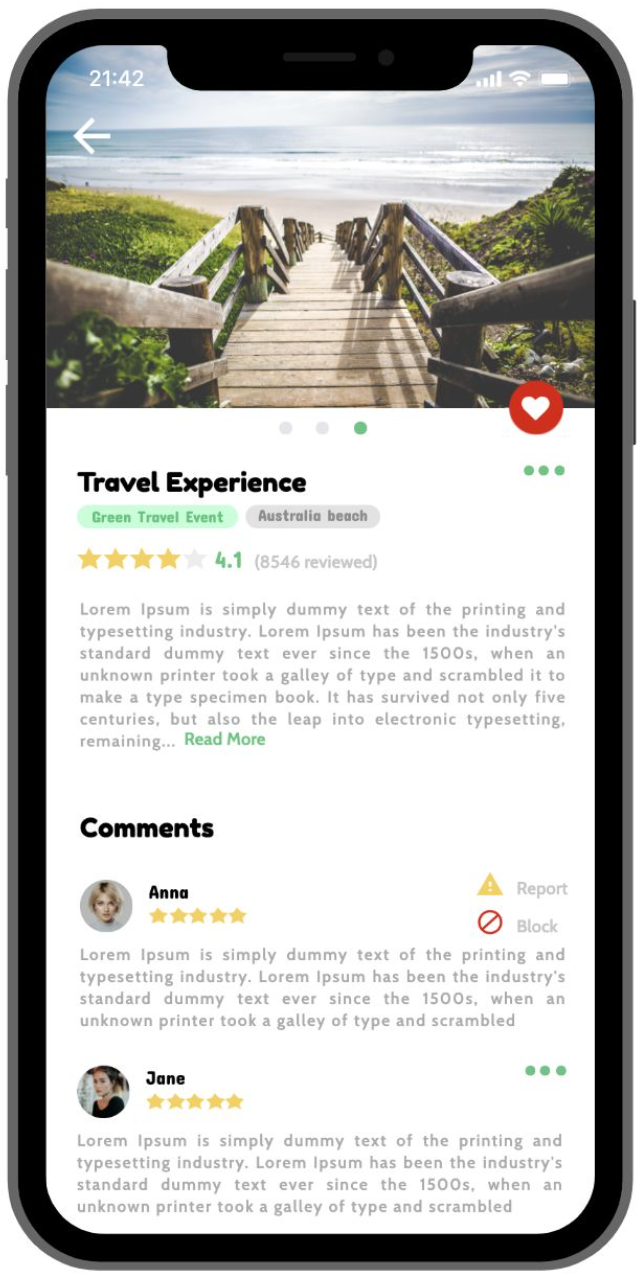
Interface 3: Green travel activity map
This is another significant feature in this app which is a map showing local green travel events and the place you can consume your reward points. These green travel events here are the real events running by some local sustainable organizations so the user can attend one of them. The green travel event acts as a guidance to lead the people who want to behave properly in the travel but they don’t know how. Also, in order to encourage users to attend green events, it will corporate with the reward system (discussed in section 3.1) that users will get benefits when they attend any of these.

Interface 4: User profile
The user profile will be accessed when the user taps another user’s avatar. This page will display each user’s basic information which includes username, the number of followers and his previous posts. The design of the posts is the same as in the home page because it is for consistency so that the user can recognize it. The reason we want to show the number of followers and the number of likes the user got us because we want to have some influencers in this app. Based on the discussion of the persuasive power on social media, these influencers are easier to lead his followers’ behaviour.
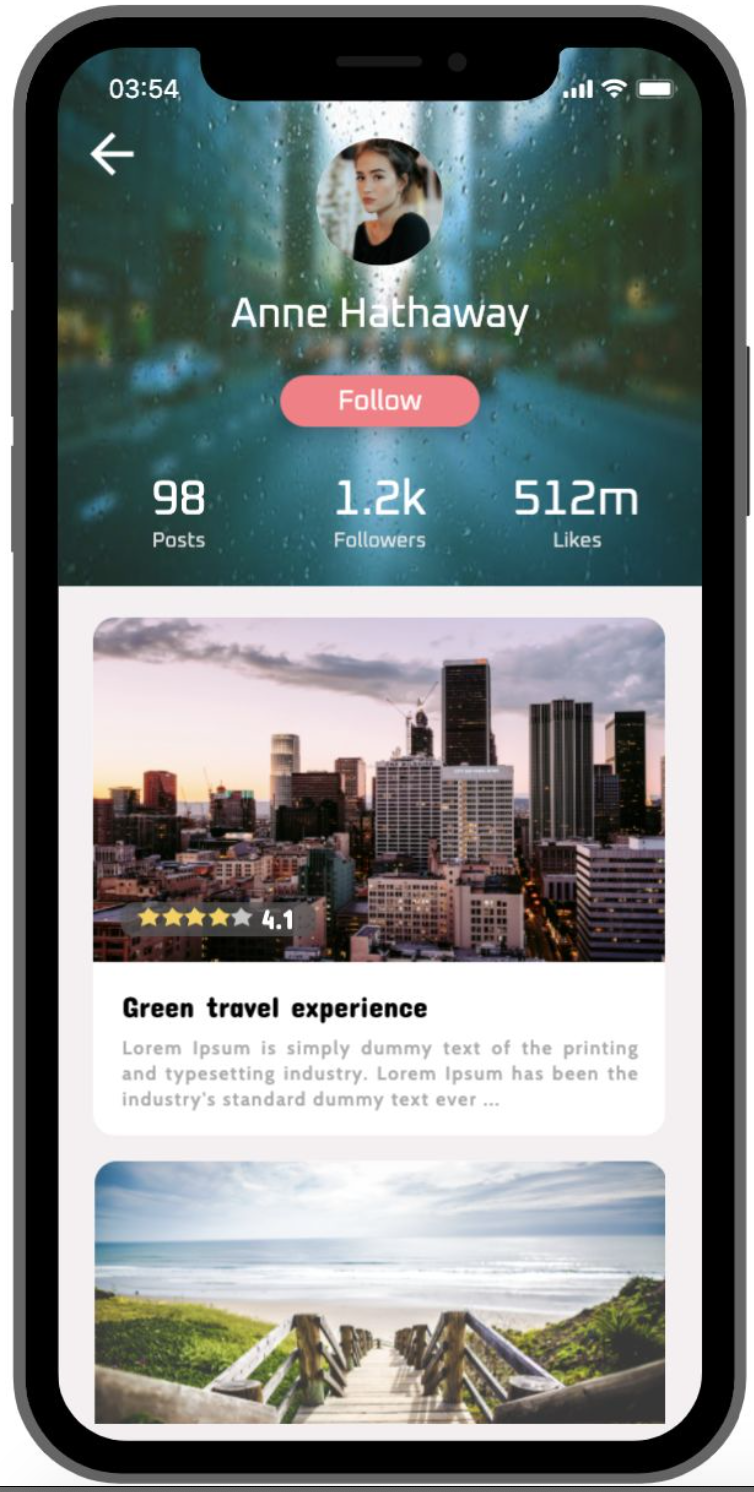
Interaction
